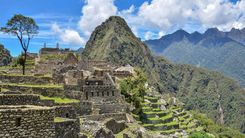14. Visit Parque Kennedy (especially at night)
During the day, Parque Kennedy is a green patch in the middle of Miraflores, known mostly for the colony of cats that live there. But in the evening, the park shifts. It becomes more of a gathering place—with artists showing their work, musicians playing live sets, and food vendors setting up around the edges.
It’s casual, but there’s a lot going on. You can grab a snack like anticuchos or picarones, listen to some music, and wander through the crowd. The surrounding streets are full of cafés and restaurants, so it’s a good place to start or end your night.
It’s centrally located and easy to get to, especially if you’re staying in Miraflores. If you’re looking for something that gives you a feel for everyday life in Lima, it’s worth stopping by. If you want to take a trip from Lima to more remote nature, see our guide to Peru's national parks.





